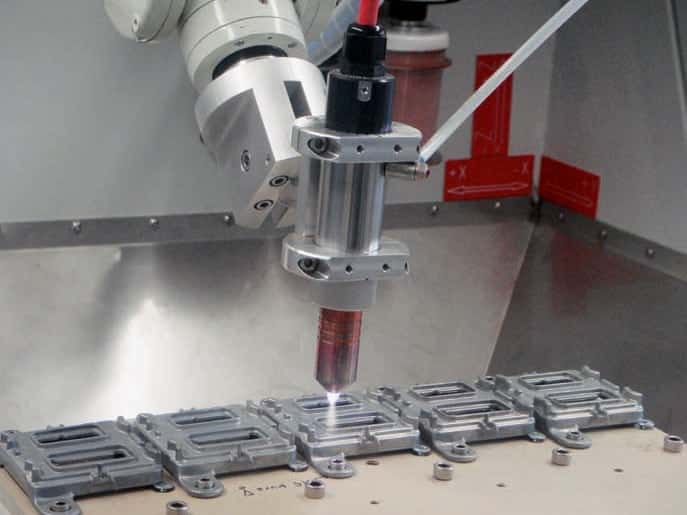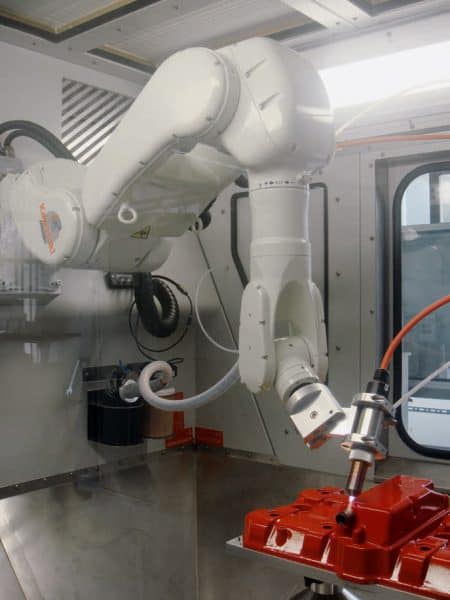Precision in the fourth dimension
Published: Automation, 08-2016, Heinrich Publikationen GmbH
Authores: relyon plasma GmbH
Without the application of plasma technologies, many industrial processes cannot be realized, or can only be realized at great expense. That is why relyon plasma has developed a concept to automate the handling of plasma generators with precision in the fourth dimension – with robots of Kawasaki.
Plasma is described as “the fourth aggregate state” after the aggregate states “solid”, “liquid” and “gaseous” and is produced when further energy is generated by means of electrical discharge
is coupled into gaseous matter. On contact with solid surfaces, plasma changes the corresponding surface properties.
In industrial applications, plasma can be used to cut and weld metals, clean the surfaces of a wide variety of products made of plastic, metal, glass, ceramics, composite materials and even textile fabrics for subsequent processes, activate them for optimum wettability and finally coat them.
»We wanted a standard robot that was absolutely reliable, highly dynamic and had high repeatability.« Dr. Stefan Nettesheim, Managing director of relyon plasma GmbH
Application in medical technology
In medical technology, plasma can be used to disinfect medical instruments and wounds, among other things, and to reduce the incidence of pathogenic germs. Relyon plasma GmbH in Regensburg is engaged in the development of plasma technologies for such and similar applications including the necessary hardware and software environment.
Relyon Plasma GmbH in Regensburg develops plasma technologies for these and similar applications together with the necessary hardware and software environment. Relyon Plasma was founded in 2002 as a subsidiary of Maschinenfabrik Reinhausen. In 2006 the company was strengthened by the acquisition of JE Plasma Consult. In mid-2014, Dr. Stefan Nettesheim and Klaus Forster bought the company out of the group as part of a management buyout.
Relyon Plasma’s customers include high-tech companies from the automotive industry, manufacturers of medical devices, machinery and plant manufacturers, as well as companies from the electrical and electronics, pharmaceutical, food, packaging, plastics, textile and clothing, and metalworking industries.
Highly automated
The systems in which Relyon plasma systems are installed are generally highly automated and designed for high throughputs. Accordingly, the developers at Relyon also had to automate the handling of the plasma generators. After all possible handling systems had been thoroughly analysed, the decision was taken in favour of a robot solution – embedded in a cell.
Dr. Nettesheim explains their requirements: When working with plasma, fine dusts are produced due to the application. That’s why we wanted a standard robot as a fully automatic handling solution that works absolutely reliably under these conditions, that is highly dynamic and has a high repeat accuracy – and all that at a reasonable price. And we needed a system integrator as a partner, because we are not automation specialists, but developers of plasma technologies.”

Bild 1: Relyon Plasma counts on the six-axis Kawasaki RS005L robot
They found what they were looking for at Kawasaki Robotics in Neuss. The managers of both companies got to know each other at a trade fair where “we were very impressed by the expertise of the Kawasaki sales engineers”, says Forster.
After detailed consultation with Kawasaki sales manager Carsten Stumpf, the Relyon developers opted for the six-axis RS005L robot. With a net weight of 35 kilograms, this device carries a payload of five kilograms, has a repeat accuracy of ± 0.03 millimetres and a reach of over 900 millimetres. The robot can be mounted as a stand-alone device on a worktable or suspended from the wall or ceiling of a robot cell, so that the work area underneath remains free for large-volume workpieces. All axes of the robot, which is controlled by an E71 controller as standard, are IP65 protected, the wrist axis even IP67.
According to Forster, the RS005L complies: all our requirements in the best possible way. There’s nothing to be complained about the robot’s dynamics, although we’ve driven it pretty hard in one or two tests. Due to its axis geometry, it can precisely position the nozzle of our plasma generator on every point of the workpiece to be treated with plasma and thus even move complex three-dimensional contours.”
In terms of communication technology, Relyon Plasma relies on the CAN bus because CAN protocols have established themselves in a wide variety of industries due to their high data security. However, Relyon ensures compatibility with other fieldbus protocols such as Profibus, Profinet, Devicenet and so on.
»The robot can precisely position the nozzle of our plasma generator on any point of the workpiece to be treated with plasma.« Klaus Forster, Chief Operating Officer of relyon plasma GmbH
For the software programming of the robot, however, the help of Kawasaki had to be called upon. In the meantime, however, some application engineers have completed training courses on robot commissioning, programming and operation in Neuss.
The Regensburg-based company is thus more independent, for example when more and more customer-specific tests have to be carried out.
Practical use

Picture 2: Due to its axis geometry, the RS005L can precisely position the nozzle of the plasma generator on any point of the workpiece to be treated with plasma, thus enabling even complicated three-dimensional contours to be traced.
At Relyon Plasma, the robotic cell is used to sample plasma processes, such as cleaning engines or sealing geometries for searchlights.
The main focus is on proving that the respective process is as safe and stable as the user wants it to be. At Relyon, those responsible have no direct influence on which robot they ultimately want to use. But they can make recommendations from their own experience and the robot solution with the RS005L is obviously able to convince: two such cells were sold to OEMs from the automotive industry in mid-2015 as an integral part of two production plants – to Brazil and China.
A market with a future
The employees around Dr. Nettesheim and Forster have already identified a new, promising growth market: the shoe industry, specifically the manufacturers of sports and leisure shoes.
This is where mechanical engineering “Made in Germany” meets customers from all over the world, very quality-conscious, very innovative with regard to new materials and always on the lookout for safe manufacturing processes for large series products, with production branches primarily in Asia. So you can be curious.






